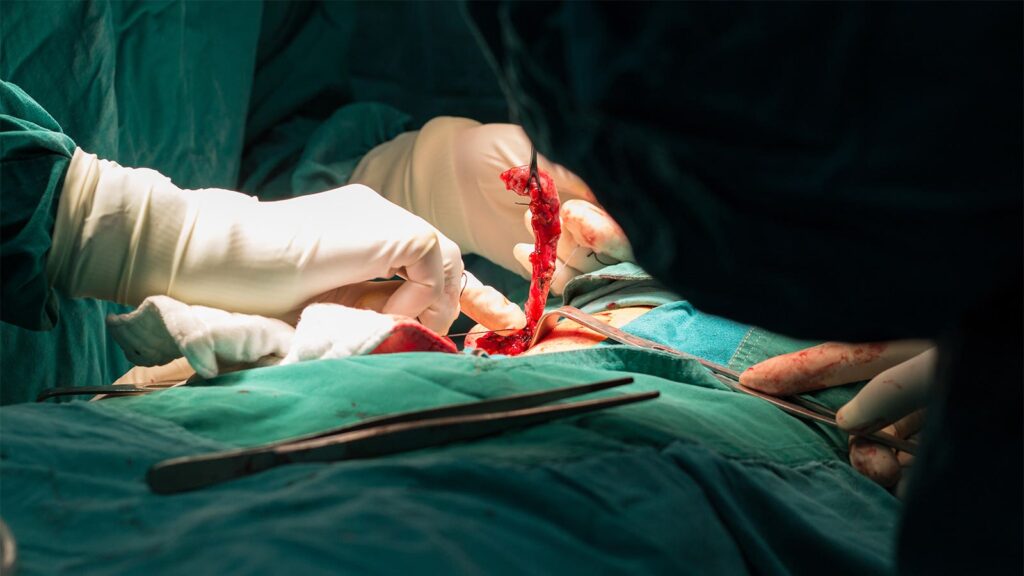Antibiotic management of acute uncomplicated appendicitis among children was inferior to appendectomy, a randomized non-inferiority trial showed.
For nearly 850 children with available primary outcome data, treatment failure at 12 months occurred in 34% of those who received antibiotics compared with 7% of those who underwent appendectomy, a difference of 26.7% (90% CI 22.4-30.9) that exceeded the 20% non-inferiority margin, reported Shawn St. Peter, MD, of Children’s Mercy Hospital in Kansas City, Missouri, and colleagues in The Lancet.
Treatment failure was defined as removal of the appendix in the antibiotic group, and as a normal appendix based on pathology in the surgery group, as well as additional appendix-related procedures requiring general anesthesia in either group.
All but one patient meeting the definition for treatment failure in the surgery group had negative appendectomies. For those who underwent appendectomy in the antibiotic group, 8% had normal pathology.
“Given the increasing interest in treating children with uncomplicated appendicitis without surgery, considering the comparative outcomes of these two very different treatment approaches is important to guide treatment decisions,” St. Peter and team wrote. “Although previous studies have described populations of children treated with either surgery or antibiotics, there has not been a large, randomized study with the benefit of removing the possibility of selection or other bias.”
“The implication of the 20% non-inferiority margin in this trial is an underlying assumption that to realize the potential benefits of avoiding surgery, patients or surgeons would be willing to accept a failure rate with antibiotics that is 20% higher than that with surgery,” they noted.
In an accompanying editorial, Diana Lee Farmer, MD, of the University of California Davis Children’s Hospital in Sacramento, pointed out that the trial protocol, including the 20% non-inferiority margin, which she supported, had been vetted by experts and published in 2017.
“Although no one ever wants a child to have an unnecessary operation, children across the globe still die or have severe morbidity due to inadequate access to surgical care, and some of those are dying from appendicitis that is untreated or treated too late,” Farmer wrote.
“As a global group of pediatric practitioners, we still find it difficult to predict who will survive a perforated appendix and who will not,” she continued. “In my opinion, this article resolves the question for high-income countries: antibiotic treatment alone is inferior to appendectomy in the treatment of uncomplicated appendicitis.”
Despite her positive impression of the trial and finding its conclusion satisfactory, Farmer noted that it was limited by its absence of diversity in patient populations and hospital environments, since “all sites were in high-income countries with well-equipped healthcare facilities.” That means the results are not necessarily generalizable across the globe, she wrote.
“Outcomes would probably be poorer in settings where access to a safe operating environment for children is delayed by availability,” Farmer added. “For low-income and middle-income countries, the question remains unanswered. Throughout the world, availability of resources still defines the best care in each environment and remains a crucial issue in children’s healthcare.”
For this open-label study, St. Peter and colleagues enrolled 936 children ages 5-16 from January 2016 to December 2021 across 11 children’s hospitals in Canada, the U.S., Finland, Sweden, and Singapore. All had suspected non-perforated appendicitis based on clinical exam, with or without radiological diagnosis. At 12-month follow-up, primary outcome data were available for 846 (90%) patients.
Randomization was stratified by sex, institution, and symptom duration (≥48 hours vs
Patients in the antibiotic group were admitted for observation and started on intravenous fluids, antibiotics, and analgesia; antibiotics were determined by each local site. Discharge occurred only after at least 12 hours of antibiotic therapy in patients tolerating a regular diet with good pain control and normal vital signs.
Those who did not improve enough to prepare for next-day discharge were given an additional day of antibiotics or scheduled for the next available appendectomy, determined jointly by the patient and their family and care team. Patients whose condition deteriorated on the first day or who did not begin improving by the second day after admission were scheduled for appendectomy. Discharged patients were prescribed 10 days of oral amoxicillin-clavulanic acid or ciprofloxacin and metronidazole.
Children undergoing appendectomy were also started on intravenous fluids and antibiotics but scheduled for laparoscopic appendectomy in the next available slot. Those with perforated appendicitis were treated according to local protocol. The type of antibiotics used was based on location and was the same as those used in the antibiotic group.
There were no deaths or serious adverse events in either group. The relative risk of having a mild-to-moderate adverse event in the antibiotic group compared with the appendectomy group was 4.3 (95% CI 2.1-8.7, P
Disclosures
The study authors reported no disclosures.
Farmer reported no disclosures.
Primary Source
The Lancet
Source Reference: St. Peter SD, et al “Appendicectomy versus antibiotics for acute uncomplicated appendicitis in children: an open-label, international, multicentre, randomised, non-inferiority trial” Lancet 2025; DOI: 10.1016/S0140-6736(24)02420-6.
Secondary Source
The Lancet
Source Reference: Farmer DL “Antibiotics alone versus appendicectomy for uncomplicated appendicitis in children” Lancet 2025; DOI: 10.1016/S0140-6736(25)00096-0.
Please enable JavaScript to view the comments powered by Disqus.
Source link : https://www.medpagetoday.com/gastroenterology/generalgastroenterology/113858
Author :
Publish date : 2025-01-21 16:04:55
Copyright for syndicated content belongs to the linked Source.
